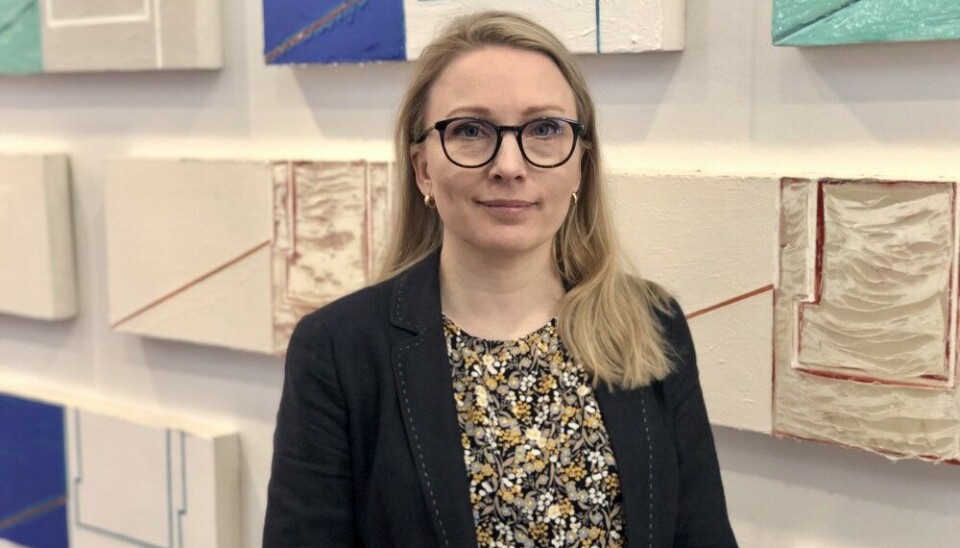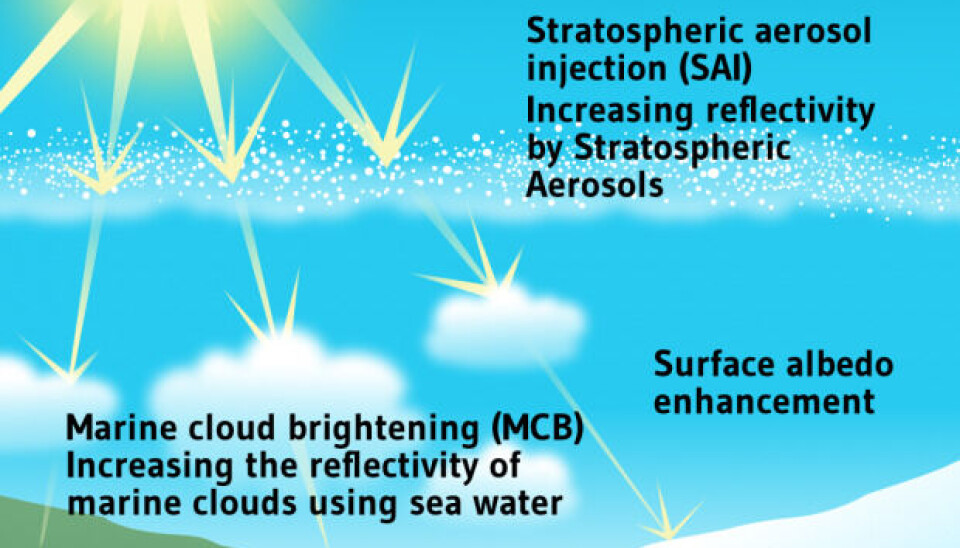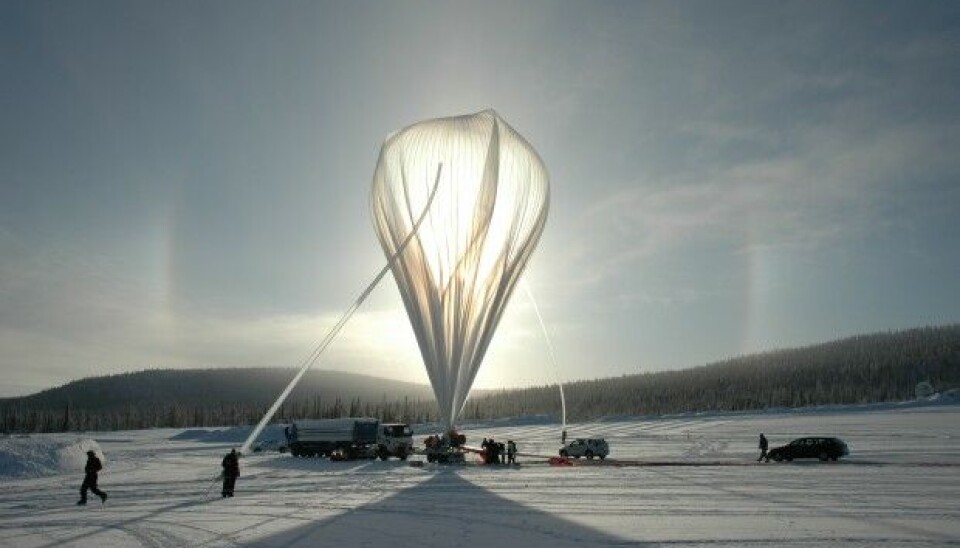
Can climate engineering be responsibly tested?
Researchers at the Finnish Arctic Centre at University of Lapland investigate if, and under what conditions, solar geoengineering can be responsibly tested and how research should be governed.
Due to insufficient cuts in greenhouse gas emissions, the idea of climate interventions as a supplementary method for curbing global warming has gotten more attention over the past years.
The aim of keeping global warming at a relatively safe level of 1.5°C is according to the most recent report released by the United Nations International Panel of Climate Change (IPCC) not looking promising. The report states that the rate at which global emissions are reduced is too slow for meeting this goal by 2100.
One form of climate intervention that has gained the European Union’s attention is solar geoengineering, also known as Solar Radiation Modification (SRM). This is an umbrella term for a set of technologies that aim to lower Earth’s temperature by reflecting sunlight away or by allowing more heat to escape into space.

SRM research is a controversial issue: some are concerned about its political implications and current uncertainties and risks over its deployment, while others view it as a potential chance to limit the harms of our warming planet. So far, there has been limited research and public deliberation on experimental research, testing, and potential deployment of SRM technologies.
The European Union has asked for support to examine whether, and under which circumstances, SRM research may be justified from scientific and societal viewpoints - as well as how research could be governed responsibly, and whether the present European Research Area regulations are suitable for the task.
These questions are to be answered over the next three years by the Co-CREATE project: a consortium of European researchers, including the Arctic Center at Lapland University.
The Arctic Centre’s team is composed of professor John Moore (glaciologist and climate researcher), professor Timo Koivurova (legal scholar), and Ilona Mettiäinen (environmental social scientist).
Mettiäinen and her colleagues will examine SRM research from social, legal, ethical, and scientific perspectives.
“We will look at the technical scientific side, how current international jurisdiction and governance frameworks can be applied to solar geoengineering research, ethical perspectives, and whether previous research has engaged communities and people. Moreover, public engagement has a central role in the project, including an inclusive expert and stakeholder dialogue process,” she explains.
What are the SRM technologies?
SRM technologies include:
- Stratospheric aerosol injection (SAI), which involves injecting tiny reflective particles into the lower stratosphere to scatter sunlight back into space, resulting in planetary cooling. Balloons or airplanes can be used in the process. This is the most researched technology.
- Marine Cloud Brightening, which would inject sea salt aerosols into low clouds in the sea, to increase their reflectivity. Today, this technology has been developed quite far.
- Surface albedo enhancement, which in theory would aim to reflect sunlight off the Earth’s surface. The technology could also be used as a local adaptation strategy in cities by painting roofs white, and thus decrease the warming of the urban area.
- Cirrus Cloud Thinning, which reduces the number of cirrus clouds (wispy, feather-like clouds) to trap less heat on Earth.
Mettiäinen explains that many of the ideas to the technologies stem from real life scenarios. As an example, the idea for marine cloud brightening is inspired by ship tracks, which forms clouds resembling long strings over the ocean.
The Arctic in focus
The Arctic is a cross-cutting theme in the project. This is because warming happens faster in the region - at a rate estimated of around three times faster, or, in the Barents Sea area, four times faster than, elsewhere.
Research shows that already exceeding 1.5°C global warming could trigger multiple irreversible climate tipping points in the Arctic, such as abrupt loss of the Barents sea ice, a collapse of the Arctic winter sea ice and Greenland ice sheet.
“In order to avoid reaching these tipping points many think it is also necessary to investigate climate interventions,” Mettiäinen says.
Crossing these crucial thresholds in the Arctic would trigger a domino effect of irreversible changes on climate systems.
As an example, the rapid warming of the Arctic is causing faster melting of the Greenland Ice Sheet and Arctic sea ice. This in turn could potentially slow down the Atlantic Meridional Overturning Circulation, which is an ocean current helping to redistribute heat around the globe, influencing weather patterns and climate. The slowed ocean current could lead to changes in South American monsoons, which in turn may lead to more frequent droughts in the Amazon rainforest, reducing its ability to store carbon and intensifying climate change.
Arctic case study
The Arctic will be the special focus area for the Lapland team, as they will participate in developing a case study focusing on area-specific circumstances for responsible governing of SRM research in the region.
The project aims to compile a total of five to six case studies to provide a thorough understanding of responsible SRM research governance for different contexts in the European Research Area. The case selection will consider different factors, for example in choosing regions where research could be conducted.
By the time the project concludes in 2026, the goal is to have increased the understanding of whether, and under what circumstances, research can be conducted in an ethical, responsible and fair manner. The project will also have developed guidelines and principles for a governance framework for SRM research including experiments. The work will also assist research funders in determining whether they wish to support such research.
Mapping the science
In the initial stage of the project, the focus will be on mapping the current landscape of SRM research, including methodologies in use as well as identified risks.
So far, solar geoengineering has been generally researched from a Natural Science perspective, through climate modeling. Simulations have been used, for instance, to explore the regional and global climate impacts of different scenarios, for example by considering the different amounts of particles that would be added to the atmosphere by stratospheric aerosol injection.
There are fewer studies in which researchers have involved and engaged with communities, but they do exist. For instance funding has been provided to researchers in the Global South to analyze local impacts of solar geoengineering and expand the conversation around SRM with local stakeholders.
Essential to involve the public
So far solar geoengineering has mainly been discussed among experts in the Global North. Yet, public acceptance is crucial for research to take place, as seen in recent cases.
Such a case took place in Kiruna in 2021, when a Harvard research group was prohibited from launching a balloon into the stratosphere to test equipment for possible future aerosol release (as part of the SRM technology known as Stratospheric Aerosol Injection).The test was objected by the Sami Council and environmental groups in an open letter, stating that the research “must not be advanced in the absence of full, global consensus on its acceptability”.

It is important to increase awareness and public discussion about the technologies and to consider the public’s support as part of the governance framework, Mettiäinen says.
Later on, the researchers will listen to stakeholders’ opinions and engage them in the conversation. There will be meetings and workshops with politicians, experts, government officials, the general public, indigenous populations in the Arctic, and communities from the Global South.
“Everybody is a stakeholder concerning the atmosphere. And when it comes to Indigenous people, they’re considered Rightsholders (as declared by the UN Declaration on the Rights of Indigenous Peoples),” Mettiäinen says.
Why is SRM controversial?
Regardless of whether one is for or against solar geoengineering, scholars agree that the technology does not address the root cause of climate change. Moving away from burning fossil fuels and reducing greenhouse gas concentrations in the atmosphere is crucial to combat global warming.
“The primary solution to climate change is decarbonisation. Also planned adaptation is needed for coping with those climate induced risks that are already observed or cannot be avoided anymore, given the emission levels in the atmosphere. Climate interventions such as SRM have been suggested to serve as a supplement to buy us time for efficient emission reductions to work, for instance “shaving off” the highest temperature peak,” says Mettiäinen.
Nevertheless, opinions diverge on whether solar geoengineering should even be developed.
In 2021, scholars and scientists opposed to SRM technologies published an open letter calling for a Non-Use Agreement.
The letter proposes a full stop to the development and future deployment of SRM technologies, because of its many uncertainties and risks - for instance on rainfall, which would then affect agriculture and water availability.
The letter also refers to the “moral hazard”, suggesting that SRM could weaken political resolve by diverting attention and resources away from mitigation efforts, and giving countries and companies an excuse to slow decarbonisation.
A third argument is that the deployment of SRM technologies is undemocratic, since it cannot be governed globally. Furthermore, some countries may use the technology for their own interest without considering global effects.
As a response to the Non-Use Agreement, researchers in favour of SRM research published an open letter expressing need for faster action in lowering the planet’s temperature. The letter states that mitigation efforts aren’t happening fast enough to avoid hitting crucial climate tipping points in the near future.
Mettiäinen stresses that support for research doesn’t automatically mean researchers support the deployment of these technologies.













